Caged: Prey as a Horror Game
By gamer_152 3 Comments
Note: The following article contains major spoilers for Prey.
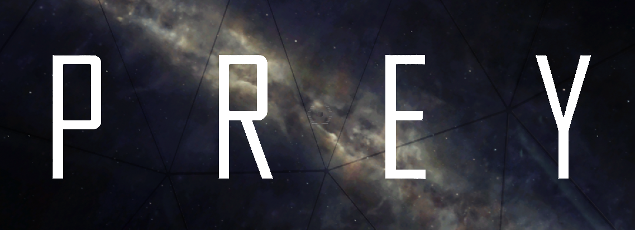
If you want to create a sci-fi horror game, you first have to consult the Bible from which sci-fi horror games draw: The Alien universe. Halo, Metroid, Dead Space, Doom, SOMA, and plenty more outer space creepfests worship at the altar of Alien, and an even broader set of games owe a debt to the series for popularising automated turrets, motion trackers, grimy industrial corridors, and other common phrases in the language of games. However, when interactive media does borrow from Alien, it mostly borrows the visual design, technologies, and premises, but the Alien films are more than facehuggers and derelict spaceships. Alien would not be Alien without an omnipresent, amoral corporation driving its characters over the cliff, and video games haven't been as compelled to render that concept with as fine a brush. For that matter, why did Alien think it needed its oppressive megacorp?
There's a rich history of critiquing horror entertainment as expressing the cultural anxieties of the period it was created in, and we can do this with Alien. The first two films from the series, which are by far the most influential and acclaimed, soared into cinemas in 1979 and 1986 respectively. By the late 1970s, the American public had grown disillusioned with their government after the scandal of Watergate and the massacres of the Vietnam War, and the private sector was putting on its best suit and tie to pitch itself as an alternative driver of society. However, the working-class across the country were also finding little succour in big business.
The 70s saw recession and unemployment; heading into the 80s, private industry benefited from sweeping deregulation; the country, as a whole, saw increasing wealth disparity. So as films situated in the 70s and 80s, Alien and Aliens projected a more believable version of the future for Americans than the optimistic and peaceful Star Trek of the 60s. At the time, it seemed more likely that the final frontier would be ventured into not by an intergalactic United Nations but by a space-fairing corporation who couldn't care less about the manual labourers slaving away for their profit. Those labourers are depicted throughout the films as understandably paranoid and vulnerable. The convention for the horror genre is that the protagonists would be able to live relatively comfortable lives if it weren't for the monsters who invade their world, but in Alien, even without the Xenomorphs, the best the characters could hope for is a lifetime of drudgery under the Weyland-Yutani Corporation.
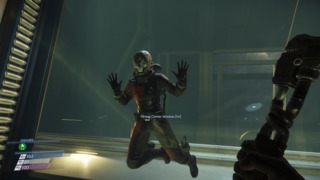
Arkane Studios's Prey follows in the three-toed footsteps of Alien. It's another far-future sci-fi in which a species of predators from beyond the stars attack the workers of an uncaring corporation. In both sets of media, the corporation attempts to extract samples of the alien species for use in technologies that will help profit them, and we see that decision endanger their crew. Both Alien and Prey even have their own facehuggers. But what Prey is interested in copying over from Alien, perhaps more than any game before it, is the toxic corporate structure its characters work in.
In the Prey universe, the American, and for a time, Russian government controlled the "Kletka", a space station which studied the dangerous extraterrestrials they called the Typhon. After a containment breach, the station was shut down, and the project was labelled a failure. In 2030, the facility was privatised and given over to TranStar Industries who renamed it "Talos I" and declared their research aboard the station a success after it led to the revolutionary Neuromod technology. TranStar then met the same fate that the previous occupants did as the Typhon assumed control of the building, only this time, the heads of the station might have also given the Typhon a passage to Earth. As in Alien, the main antagonist of Prey may be the aliens, but the central characters are placed in harm's way and severely mistreated by the megacorp that employs them. Where Prey deviates from Alien is that while Alien depicted fear and suffering in a working-class workplace, Prey has it occurring in both working-class and middle-class spaces. We can read Prey as a commentary on hostile companies and workplaces, and perhaps that feels like a stretch, but before dismissing it, consider who the enemies of the game are and what our job is aboard the Talos I.

We play Morgan Yu, a researcher who has been recruited to TranStar Industries by their executive brother Alex. The game begins as they wake in their apartment on March 15th, 2032. They take a helicopter trip to the TranStar HQ and participate in a number of experiments. A rogue Typhon attacks the lead researcher behind those experiments and Morgan is anesthetised. The game appears to start over, but in the second iteration of the opening, it reveals that the flat, helicopter trip, and TranStar building are part of an elaborate simulation. The date is no longer 2032; it is 2035, and Morgan has been reliving the same day over and over in the simulation for three years, having their memory wiped every 24 hours. Morgan had been playing guinea pig in the development of a new Neuromod.
Neuromods are devices based on the neurological scans of the brightest people from each artistic and academic field, and when injected into a user's brain, alter the user's neurology to give them the same skills as those geniuses. The mechanism of neurological replication works using material taken from the Typhon and was developed in experiments on prison inmates who did not give informed consent and often died painfully during testing. Unfortunately for the consumer, uninstalling the Neuromod means wiping all of their memories since they injected it and that mind wipe is what happened to Morgan. They consented to exist in the simulation for three days, but after the Typhon breakout, which is what killed the lead researcher, TranStar left them in the simulation until they could bring the crisis under control. They did not bring the crisis under control. January, an AI that turns out to be a consciousness created using an earlier brain scan of Morgan, breaks them out of the simulation. We later discover that the continual installation and uninstallation of Neuromods also caused personality changes in Morgan.
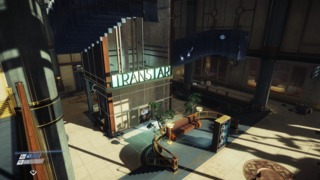
The Talos I you explore as Morgan incorporates wood-panelled offices with an art deco style. The art deco look is not just there to bring out space-age nostalgia, its a type of interior design commonly associated with the wealthy and so signals the corporation's wealth. Arkane also makes a special effort to organise the station into areas that serve unique functions to the company and to design those areas in a way appropriate for their functions. From the maintenance tunnels of the G.U.T.S. to the gardens of the Arboretum, every board and beam of Talos I feels like it was laid with TranStar's mission in mind rather than fabricated as part of a video game level. Scattered emails and audio logs which detail the work done in each of these areas help make the station a believable workplace. In your time aboard Talos, you also use the workers' "Looking Glass" screens which are similar to monitors but give the illusion of a 3D space behind them, while the most common enemies you encounter in these workplaces are the Mimics and the Phantoms.
The Mimics are aliens capable of turning into any small object in the environment and will almost always be in this camouflaged form when you first find them. The coffee cup on that desk or that plant in the corner may be an alien primed to strike when you least expect it. It's startling when a Mimic catches you off-guard, but cleverly, this design makes it so that the game remains tense even when there's no Mimic in your immediate vicinity. In another horror game, if you walk into a room and can't see any enemies, you can relax. At least early on in Prey, if you walk into a room and can't see any enemies, the tension stays at a consistent level because what looks like an empty room could have three or four Mimics inside, waiting to pounce. It's not just that Prey has workplaces which contain threats to us, instead, in Prey, we're taught to distrust the workplace itself, and we see it manifest as something dangerous to its employees. The game's other stock enemy, the Phantoms, are humanoids that are born when the Typhon infest one of your colleagues. Early on, their kinetic blast can cut right through your suit and flesh, making them intimidating every time you encounter them. The symbolism is pretty clear here: some co-workers are taken over by a kind of hostility and become toxic to you.
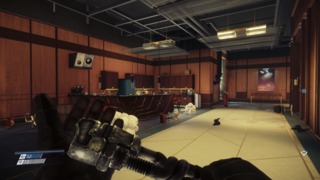
Whether facing Mimics or Phantoms, the default weapon of the wrench makes it so that the basic act of damaging these creatures leaves you vulnerable. The wrench can deal more damage than its unassuming appearance lets on, but to get those hard blows in, you have to hold it back for a short time before swinging it. Unfortunately, in that moment when you're winding up the attack, there is a window that enemies can use to take a jab at you. You can hammer at an enemy with the wrench to do small amounts of damage and knock them back, but in the long-run, this can often leave you more vulnerable as you burn off all your stamina and must wait for it to refill before you can attack again or even flee the scene. Built into every melee scuffle are these flashes of defenselessness.
Your eventual goal is to destroy the station, killing everyone on board, including Morgan, but preventing the Typhon landing on Earth. Activating Talos I's self-destruct mechanism requires one key from Morgan and another from their brother Alex who's still on the station. Inconveniently, Alex won't give us his key until he's finished making the case against blowing up the station and later puts Morgan to work scanning the ethereal substance known as "coral" which the Typhon are using to broadcast a signal into deep space. Meanwhile, various logs around the station reveal Alex to be an abusive boss whose subordinates were desperate to see the back of him. When Morgan tries to upload their research on the coral, TranStar's Walther Dahl, working for the board of directors, locks them out of the station's computers and sends the fiercest enemies yet to kill Morgan. After Morgan has subdued or murdered Dahl, Alex hands over his arming key, and clarifies that the coral's signal will attract a new kind of Typhon to Talos I. This new organism engulfs the station, but Alex has theorised that the coral network could be reverse engineered to kill the Typhon on the ship and those in deep space. In the end, you have two potential forms of recourse against the Typhon:
1. Blow up the station and be sure that you've eradicated the infestation on Talos I but lose all the Neuromod research in the process.
2. Plug a Nullwave Transmitter into the coral network to possibly kill all the Typhon on the station and maybe elsewhere in the galaxy while preserving TranStar's research. Alex also gives you his word that if you do save the work on the Neuromods, the product rollout will not be spearheaded by TranStar's shady board of directors but by you and him.
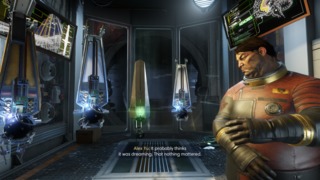
Both these endings lead on to the same epilogue in which we learn that the whole game was another simulation constructed from the real-life memories of Morgan Yu during their time on Talos I. We experienced this simulation through the eyes of a Phantom that Alex was experimenting on. In the future that this epilogue is told in, the Earth has succumbed to the Typhon, but using the Neuromod technology, Alex has been able to plug a brain scan of Morgan into a Phantom in an effort to bridge the canyon between the species. The humanity of the Phantom is judged by Alex and a few of the crew members of the Talos I based on how far you went out of your way to preserve the lives of the crew members on the station. If you did not perform adequately in that capacity, Alex executes you, looking to move onto another test subject. Otherwise, he lets you live, and in exchange, you can take his hand or murder everyone in the room.
You don't have to go out on a limb to read this plot as an expression of dissatisfaction with 20th-21st-century workplace dynamics. You have ludonarrative during which you're moving through isolated offices and industrial spaces, working for a corporation and maintaining their building, but being attacked both by the physical workplaces and by corrupted colleagues who roam the halls. It's clear that the corporation has jeopardised their workers, including you, and at the time of the game, they have ruined the whole planet in a way that the public sector version of their project, while still failed, never did. Morgan's experiences call into question the safety of the company's product, and we can see that through the Neuromods, the firm literally got inside their head, leaving something dark and dangerous there. After enough time, their relationship with the company altered their personality. The human ambassadors of the TranStar company during our time aboard Talos I are a board member doing his best to destroy us, and Alex, a tyrannical boss who at first appears to be our friend, but during both the opening and epilogue betrays our trust and pulls the wool over our eyes. Even Talos I itself is in the shape of the TranStar logo; we inhabit one gargantuan corporate symbol.
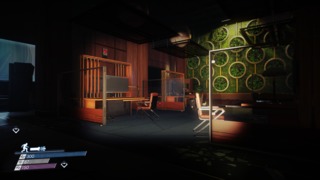
At the same time, we can't entirely characterise Prey as a horror set in an analogue to the modern workplace. Prey has all the trimmings of the "scary game" and borrows plenty of tone and commentary from Alien, but it's not horror for the majority of its runtime. In the early game, we go through the initial simulation experience, the Mimics and Phantoms hound us, we are forced to get by on scant resources, and we find the Looking Glass screens. Enemies are somewhat sparse on the ground during this period, letting anxiety build in the silence between encounters. For the opening three sectors, we can safely categorise Prey as psychological horror, but then the ground shifts.
We acquire more effective means of attack, resources become more plentiful, and fights with Typhon happen more frequently and are more prolonged. The Mimics, which were something to fear in the early game, are reduced to minor nuisances as our capabilities begin to tower over theirs, and while there are new enemies which provide an appropriate level of push-back against these capabilities, they're not as stealthy as the Mimics and so not as scary. We also find that beyond its foyer, Prey includes few moments where it’s shown that our perception of the world is disconnected from its reality, which is what the simulation sequence, the Looking Glasses, and the Mimics' abilities were suggesting. Just as we see everyday objects turn into skittering monstrosities and back again, we see Prey slip from mind game into gritty action title, only to turn back again at the last second for a psychological horror epilogue.
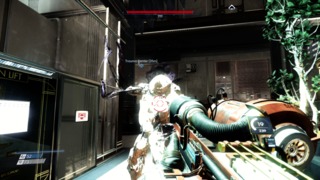
A well-designed video game uses an upward curve of increasingly harder challenges. In the same way, a well-directed horror uses an upward curve of increasingly scary scenes, and a well-written psychological thriller employs an upward curve of ever-more mind-blowing twists. If the curves in any of these types of media fail to continue along an upward trajectory, the audience loses interest, and that's what happens in Prey. At least, even if the gameplay keeps you engaged, the atmosphere and narrative become less compelling. Fighting enemies becomes less of a struggle which means that you have less to fear from the Typhon, and after the opening, you’re waiting for the game to flip your perspective on its events at any moment, but really, what you see on Talos is what you get. It’s disappointingly literalist, and you pine for moments like when you broke out of the simulation or first saw the Mimics.
If you just analyse the visual or audio design of the game, Prey's transition from horror experience to action experience is almost imperceptible. There are plot decisions which heavily contribute to it, but it's also not as if the plot prevents Prey operating as a horror. Instead, its the play which nudges Prey far from its original trajectory as a horror; it's a redirection of the game's efforts that comes down to five mechanical factors:

1. Surplus begets surplus. The designers give you food, ammo, medkits, weapon upgrade kits, suit repair kits, spare parts, and Neuromods to explore the station safely. This is because they help you overcome enemies, but it's also because you have a much better chance of reaching locked-off areas with Neuromod upgrades that let you hack machines or first aid kits that you replace depleted HP. In fact, there are various areas which you can only step foot in by using Neuromods upgrades, and it's only by exploring the station freely that you can begin to build the backlog of upgrades and items that make exploration less perilous. For the first three or four areas of the game, you must carefully weigh up the risks of exploring side rooms against the reward of the items you'll find there. But afterwards, the compulsory missions supply you with enough resources that you can begin to venture further afield and hoover up more items which makes you more able to explore which gets you even more items and on it goes. Soon you have so many items and upgrades that most enemies don't stand a chance against you which isn't very scary.
2. Designers cannot simultaneously fine-tune the amount of challenge a player faces and allow the player total freedom in how much they equip or upgrade their character. Prey is a game that bends over backwards to incorporate a rainbow of different playstyles. If you just want to play the main story, it lets you, but if you also want to get into every hook and cranny and burn through a host of side missions, the game is willing to give you a chance at that too. But, of course, more stones unturned and more missions completed means more reward. In the early game, there's not enough side content for you to have earned a lot of extra resources, but that begins to change somewhere around Psychotronics. The further through the game you get, the more chances to pick up extra items and Neuromods there are, but by the same logic, the more items and upgrades you can skip past. The further into the game we get, the wider the gap in upgrades and items between a player who has explored side content and a player who has barely done so.
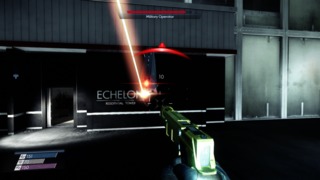
For those better-equipped players, the designers could try to sustain the tense atmosphere of the early game by giving them unforgiving gameplay scenarios that match their character's level of proficiency. However, this would make the difficulty so high as to outright lock out the players who were not interested in picking up extra boosts to their powers in the side content. So instead, the game gives us challenges that might require steely resolve from a non-exploration-driven player, but the better-equipped player finds themselves no longer breaking a sweat.
3. Throwing more enemies and more frequent fights at the player lets the game increase difficulty and increase reward. Again, in conventional game design, both difficulty and reward exist on an upward curve. The game must produce ever-increasing challenges to keep a player hooked, and it's only fair that greater challenge leads to a greater reward. More rewards mean the player will be more prepared for the next challenge, and so the difficulty must further increase. There may be solutions to increase difficulty that don't involve dropping weapon upgrade kits or more rounds, but at the very least, they're not obvious solutions. So as the game chugs along, you build a bigger arsenal and enemies become more numerous. The overall effect is a more "actiony" game.
4. Using more enemies and harder enemies in your design is a technique that evolves gameplay and forces the player to adapt their playstyle in new ways. Again, this is not the only way to create more depth in the gameplay, but think of a horror game like Outlast. It uses enemies sparingly, but an encounter with an enemy near the start of the game looks roughly the same as an encounter near the end of the game. In Prey's transition from horror to action arena, it forces players to prioritise enemies in fights, think more about positioning, and even play enemies off of each other. That's richer play.
5. Not all abilities are created equal. Arguably, some Neuromod upgrades, like the health increases, make you overpowered relative to the Typhon. Even if you don't believe that, we can all agree that a turning point comes when you obtain the shotgun. Your first chance to do so is not that far into the campaign, and the weapon does objectively more damage than any other. On Normal difficulty, the pistol will only knock 8 HP off of an enemy by default, while a wrench hits for a maximum of 20 damage, but an unmodified shotgun deals 41 damage and you can upgrade it to dole out as much as 66.
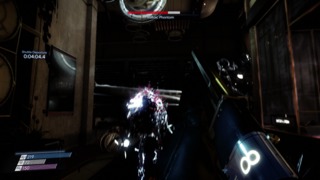
There are also damage modifiers which make any weapon a formidable ally in a fight. Get in a sneak attack or get the Firearms, Combat Focus, or Sneak Neuromods and you're one step closer to tearing any Typhon in two. They might not be so devastating except they amp up attacks by a percentage of a weapon's base damage rather than a fixed variable, meaning guns that are already powerful like the shotgun get more benefit from these modifiers than weaker weapons. If my maths[1] is right, with modifiers, the shotgun tops out at a potential 231 damage, compared to the maximum 60 of the wrench. The damage stat is, of course, offset by the usual disadvantages that balance a shotgun in an FPS: high recoil, a small magazine, a long reload time, and a short range, but none of these hold you back to the extent they might in another shooter.
Many enemies, like Operators and Mimics, already like getting up in your face once they notice you so you're often fighting a lot of them at close range anyway and a shotgun is more appropriate than a long-range firearm. Even for enemies who don't make a beeline for you, you can freeze them with the Gloo Cannon meaning that getting in close is not that dangerous. Alternatively, if you want to sneak attack them, it's possible to upgrade yourself so much that even sprinting up behind them with a shotgun won't alert them. Because you can freeze enemies and take them out relatively quickly if you wield the shotgun right, you can reload when there are no direct threats to you, making the weapon's small ammo capacity and long reload time minor inconveniences.
___
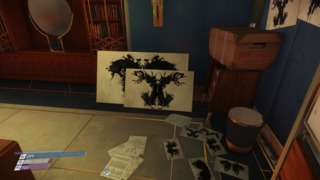
Some of these patterns are less pronounced on the Hard and Nightmare difficulties, but they all permeate the game to a noticeable degree in every mode. None of the patterns are unique to Prey, and we can find them in plenty of RPGs, but most RPGs don't introduce themselves to you as horror games, and so don't cause the genre whiplash that Prey does. It’s almost like the opening and closing of the game were written independently of the rest of the story, without much thought for what would happen in the intervening time. There’s a pleasing symmetry to them though, and the opening serves as foreshadowing for the ending. You break out of a simulation at the start; you break out of a simulation at the conclusion. The game started with Morgan looping over as part of an experiment under Alex and it ends with us finding that multiple Typhon were being run through Talos I as part of another experiment by Alex. The screens which display other realities and the inkblots that Talos I's psychologist used were also clues that, in the end, reality might not be what it appears to be.
The ending uses a clever subversion of classic sci-fi tropes. We’ve all read and watched the stories in which alien parasites set up home inside human bodies, and we've witnessed Lovecraftian organisms overtake peoples' minds. You may also have some familiarity with brain upload technology being used to transfer one person’s mind into another. Prey puts these concepts together and imagines that we could be the parasite in the alien mind instead of the other way around. Depending on how you played, you may have seen this convergence between human and Typhon not just in the Typhon's possession of human bodies but also in our ability to use Neuromods to fill Morgan with Typhon material and give them the powers of these extraterrestrial extremophiles. When Prey bothers to have a plot, it capitalises excellently on the strengths of hard sci-fi.
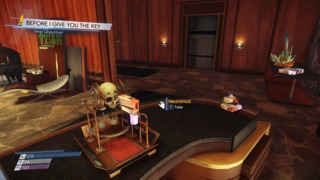
Plot twists in other forms of science fiction are often somewhat mundane or happen due to deus-ex-machinas. When technology unexpectedly saves the day in sci-fi, it too frequently functions as magic, and when writers can arbitrarily invent gadgets that can perform any job at any time, there are no risks or peril anymore. The twists at the start and the end of Prey feel ingenious because they use technologies within the world under their established rules but combine those rules in a way that is unexpected. Having hard rules for the technologies of your world makes them feel real, and when people like Alex find intelligent applications of them, it convinces us they're experts in their field.
Alex’s plan also goes against the grain of how we’re taught to deal with alien threats in speculative fiction. In most sci-fi games and films, hostile aliens are beaten back through the use of force, but with a strong enough enemy that’s not a long-term solution. The illusion in Prey is not just the illusion that we are Morgan Yu, researcher on Talos I, it's also the illusion that violence is a solution to the Typhon infestation. At the end of the game, we believe we're choosing between setting off a bomb or activating a massive psychic charge to eradicate these organisms, but they're both the same option in that they're a violent solution and lead to the same epilogue. We know that violence doesn't work because aggressive countermeasures were already taken against the Typhon, but they reached Earth anyway. Typical sci-fi characters might use an explosive act of violence as a last resort, and it would at first seem like this is the case for Prey's characters, but Alex uses an act of diplomacy as the last resort, and it’s up to you whether it works.
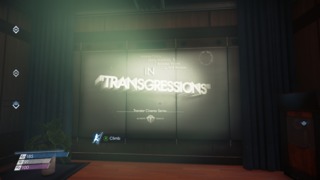
The final question of Prey is about how you react to the simulation. Do you kill Alex and his crew for putting you through it or does it persuade you that the Typhon are horrible enough that you should join forces against them? Or perhaps it’s less about your time with the game and more about the Phantom. Is a human experience enough to turn a monster into a person or is that naive? The antagonist Dahl said "We all must act according to our nature. No matter what the psychologists and priests say", but is he right? This question of whether the Typhon can be redeemed sits alongside a potentially redemptive arc for Morgan themselves. As a company executive, Morgan helped propel TranStar to success as Alex abused its employees and the company killed prison inmates for R&D. In horror, the ordeals that characters are subjected to are almost always karmic payback for their earlier ethical transgressions, and Morgan's payback comes through the oppressive corporation they helped foster. If our Morgan does not atone for their sins by saving enough of their employees, then the Morgan we experience is killed, and even if they're not, we can still decide we were playing a monster the whole time. If we conclude instead that they are redeemed then we see a human hand emerge from the dark fog of the Typhon, a symbol of newfound personhood.
The developers also make sure that wherever we are in the story when we make a narrative choice, it will have roughly equal weight to a narrative decision made at any other point in the story. While the ending we get in many interactive tales comes down to whether we choose Door A or Door B in the final scene, the ending in Prey is the cumulative result of how many "good" choices we made over its whole runtime. Even more interesting, the moral choice system in Prey is a rare case of a gameplay system we interact with without even knowing it's there. There's an adage that says that if you want to know how moral a person is you should observe what they do when they think no one’s watching. In Prey, we make ethical decisions, but they don't appear to be influencing what we mechanically refer to as a “moral choice system”. This is not to say that there are no mechanical incentives for helping the crew of Talos I; you get to tick off quests, and sometimes completing side missions provides you with more items. However, if you do the "right thing", it's never because you get more morality points or because it's hinted that the game might pat you on the back at the end for being the good guy. The closest you get is that when you first meet Security Chief Sarah Elazar, she tells you that "The only thing that matters is how you treat the people that are still alive", but at the time, this comes across as just her personal opinion. In comparison to the morality systems of other games, Prey's ethical mechanics are less sullied by gameplay-based scoring. Of course, this is all assuming that what you see at the end of the game isn't another simulation. The developers and Alex distort your perception twice, and that leaves you with lingering anxiety than maybe none of it's real.
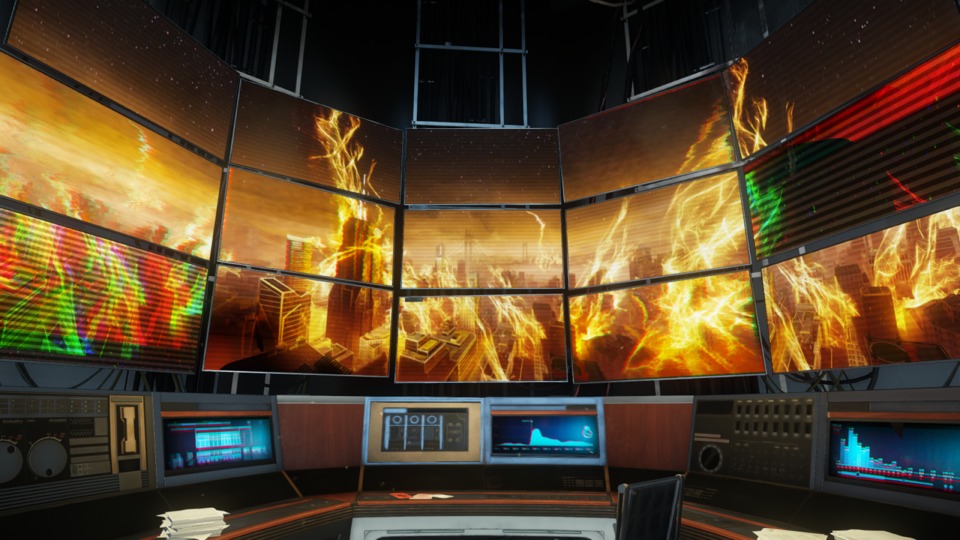
As neat as this of all is, it's a lot more fun to discuss Prey's ending than it is to play through it. It's at least satisfactory, but its effect is marred by a couple of defects in the writing:
1. The events of the story occurring within a simulation mean that the plot was pre-determined, and gets the game within a hair's breadth of telling you that "It was all a dream". It attempts to save itself with the excuse that the dream/simulation was based on real events which salvage it to a certain extent, but still leaves the story saddled with many of the problems that dream stories have. The reason we react so repulsed by "The protagonist was dreaming" endings is because we discover that there were never stakes to the story; nothing the character did in the dream had any consequence.
Prey anticipates this reaction, even having Alex say "It probably thinks [...] none of this mattered", and your choices did matter in that they were part of a trial that decides whether you live or die. However, even if Prey has stakes in this sense, it does not have the stakes it made us believe it did while the simulation was still running. We thought we were determining whether Morgan and the crew live or die and whether the Typhon make it to Earth, but these battles were already lost. That feeling of beating back the Typhon that you get with each kill is an illusion. A video game that misleads its protagonist and is only ever seen from the perspective of the protagonist must necessarily mislead its audience about their accomplishments, and that's bound to cause some resentment.

2. Prey presents all these interesting concepts only to have the game end immediately so it can't elaborate on any of them. It's somewhat unusual that Prey's design is so free of the telltale signs of studio meddling that typically suck the depth and exploration from a game, and yet, it has this final scene which feels expressly written to set up a sequel.
___
You don't have to search far to find video games that are tonally or thematically compromised because their systems don't work in concert with each other or because their story is incompatible with the mechanics used to express it. This is part of what's happening in Prey, but more unusually, Prey retains a strong sense of tone throughout. Near the start and at the end, its unpredictable environments and the uncertainty in our perceptions make it cerebral and speak to the discomforts of the modern workplace, while through the middle of the game, its action is lavish and full of possibility, but there's little relation between these sections. Prey is someone's Christmas turkey stuffed with ice cream; it's a three-piece suit where one of the pieces is a graphic tee. Prey promises to play mind games with you, but in the end, its most mischevious act of mental trickery is making you think you're going to experience mind games throughout Talos I. Thanks for reading.
Notes
1. Base wrench damage is 10, or if you wind up the attack, 20. Base shotgun damage is 41, but 66 if you have fully upgraded the weapon. The Sneak Attack II Neuromod will make it so that either of these weapons will do an extra 150% damage to an enemy if you can sneak attack them. The Combat Focus III Neuromod makes it so that either of them will hit for an extra 50% during Combat Focus. The Firearms II Neuromod can increase the damage done by shotguns by another 50% but does not affect the wrench as it is not a firearm. Combined, these modifiers give the wrench a 200% damage increase and the shotgun a 250% damage increase. This means that while in Combat Focus and sneaking up on an enemy, with all aforementioned Neuromods applied, the wrench will hit an enemy for 30-60 damage, while the shotgun can hit for 143 damage or 231 if fully upgraded. This is all assuming you're playing on Normal difficulty.
3 Comments